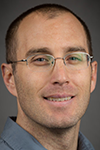
Research Interests:
My primary research interest is to couple quantitative soil spatial information from digital soil mapping with environmental process modeling to refine our understanding of the biophysical land processes that influence managed and natural ecosystems. Environmental process models (e.g., hydrologic or ecologic models) are extensively used to understand complex biophysical land processes, to forecast ecosystem response to climate change, and to assess potential physical, chemical, and biological land and water degradation. Soils are fundamental to environmental process modeling because soils are the interface between hydrological, land surface, and climate processes. Quantitative spatial soil information about the nature, distribution, and uses of soil is needed in these models to resolve detailed spatial processes and enable more accurate forecasts. Digital soil mapping (DSM) provides the needed soil information for such models. Digital soil mapping is the application of quantitative modeling and advanced computing methods to integrate geospatial environmental covariates with field- and laboratory-based soil observations to predict soil spatial distribution and associated prediction uncertainty.
My second research interest is quantitative pedology. Quantitative pedology is the application of geospatial tools and technologies to quantify the multivariate processes driving pedogenesis to enhance understanding of basic pedogenic processes. Digital soil mapping techniques can be adapted to advance our understanding of the processes driving pedogenesis at local and regional scales. Pedogenic studies currently rely on finding geographical areas where four of the five soil forming factors are relatively constant and then sampling across a gradient of the varying factor. A little explored alternative is to couple quantitative environmental covariates with multivariate statistical analysis to understand pedogenesis. Such methods enable quantification of the influence of individual soil forming factors, and the interactions between factors, to infer the biophysical processes responsible for soil development and spatial distribution across multiple spatial scales.
Education:
Ph.D., Soil Science. Utah State University, Logan, Utah, USA (2014)
M.S., Soil Science, Utah State University, Logan, Utah, USA (2009)
B.S. (Valedictorian), Physical Geography, Utah State University, Logan, Utah, USA (2006)
Professional Appointments:
2012 - Present: Associate Professor of Pedology. Dept. of Plant and Environmental Sciences, New Mexico State University.
2016 - 2022: Assistant Professor of Pedology. Dept. of Plant and Environmental Sciences, New Mexico State University.
2014 - 2016: Post-Doctoral Research Scientist. Dept. of Plants, Soils, and Climate, Utah State University
2007 - 2014: Graduate Research Assistant. Dept. of Plants, Soils, and Climate, Utah State University
2005: GIS Technician. USDI Bureau of Land Management, Shoshone, Idaho USA
2004 - 2005: Assistant Manager. Geospatial Teaching Lab. Utah State University
Recent Publications:
-
Pahlavan-Rad, M.R., Khormali, F., Toomanian, N., Brungard, C.W., Kiani, F., Komaki, C.B., Bogaert, P. 2016. Legacy soil maps as a covariate in digital soil mapping: a case study from Northern Iran. Geoderma.279, 141-148. http://dx.doi.org/10.1016/j.geoderma.2016.05.014
-
Chaney, N.W., Hempel, J.W., McBratney, A.B., Nauman, T.W., Brungard, C.W., Odgers, N., Wood, E.F. 2016. POLARIS: A 30-meter Probabilistic Soil Series Map of the Contiguous United States. Geoderma. 274, 54-67. doi:10.1016/j.geoderma.2016.03.025
-
Brungard, C.W., Boettinger, J.L., Hipps, L.E. 2015. Wind Erosion Potential of Lacustrine and Alluvial Soils Before and After Disturbance in the Eastern Great Basin, USA: Estimating Threshold Friction Velocity Using Easier-to- Measure Soil Properties. Aeolian Research, 18, pp. 185-203.
-
Brungard, C.W., Boettinger, J.L., Duniway, M.C., Wills, S.A., Edwards Jr., T.C. 2015. Machine learning for predicting soil classes in three arid landscapes. Geoderma, 239-240, pp. 68-83.
-
Pahlavan Rad, M.R., Toomanian, N., Khormali, F., Brungard, C.W., Komaki, C.B., Bogaert, P. 2014. Updating soil survey maps using random forest and conditioned Latin hypercube sampling in the loess derived soils of northern Iran. Geoderma, 232-234, pp.97-106.
-
Brungard, C.W., Boettinger, J.L. 2012. Spatial prediction of biological soil crust classes: value added DSM from soil survey, in: Minasny, B., Malone, B.P., McBratney, A. (Eds.), Digital Soil Assessments and Beyond: Proceedings of the 5th Global Workshop on Digital Soil Mapping. CRC Press, Sydney Australia, pp. 57-60.
-
Brungard, C.W., Boettinger, J.L. 2010. Application of Conditioned Latin Hypercube Sampling for Digital Soil Mapping of Arid Rangelands in Utah, USA, in: Boettinger, J.L., Howell, D.W., Moore, A.C., Hartemink, A.E., Kienast-Brown, S. (Eds.), Digital Soil Mapping: Bridging Research, Production, and Environmental Application, and Operation. Springer, Dordrecht, pp. 67-78.
Research Funding:
-
2015-2017. Utah Division of Wildlife Resources. "Interactive e ects of soils and Funding browsing on sagebrush: implications for restoration success." PI: Veblen, K. Research Partners: Nehring, K., Boettinger, J., Schupp, E., Thacker, E., Villalba, J.,Brungard, C., Duniway, M., Monaco, T., Scott, A., Shannon, J, Nielson, N., Wood, C., Wallace, G., Eddington, D., Mitchell, D. $13,508 (total award $137,000)
-
2015 USDA Forest Service. "Soil characteristics of interior west forests". PI: Boettinger, J.L. Co-PI: Brungard, C.W. $11,000.
-
2012-2014 USDA Natural Resources Conservation Service. "Digital soil mapping of soil properties and historical aerial photo analysis as tools for developing and testing ecological site concepts". PI: Duniway, M. Co-PI: Brungard, C.W.. Collaborator: Baker, B. $39,426.
* Unavailable to take on new graduate students.